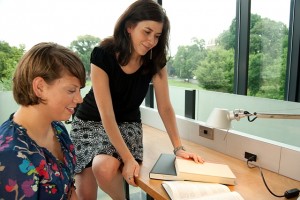
Emily Melvin '12 and Professor Rebecca Kissane
When natural disasters strike, “the need to rebuild” is a common catchphrase. But for Emily Melvin ’12 (Seaford, N.Y.), restoring infrastructure is only half the battle in recovery. The rest involves something much less tangible – rebuilding lives.
She got a taste of what it’s like to live through a natural disaster when a 6.3 earthquake rocked Christchurch, New Zealand, where she was a study abroad student this past February. As a geology and American studies double major, Melvin was at first excited to experience and have the opportunity to study an earthquake. With strong aftershocks still affecting the city, she and the rest of the students were relocated to a different university a few hours from Christchurch. That’s when she began to see the human element amid the physical disaster.
“Having never been in an earthquake, I wasn’t aware of how strong a quake it had been,” she recalls. “Everyone in my study abroad group dealt with the earthquake differently. I found it difficult to adjust to the new university as we began the semester late, were taking different courses than we originally enrolled in, and were living off campus. Some returned to America, most struggled to adjust, and some appeared not affected. These different reactions made me think it would be interesting to examine how study abroad students react to natural disasters.”
Melvin created and designed her project through the National Academy of Engineering’s Grand Challenges Scholars Program. In 2008, the NAE identified 14 Grand Challenges for Engineering in the 21st century. Three other Lafayette groups also were selected to receive funding through the program. Beginning their projects this summer, they will complete them in their senior year. Through a gift from a Lafayette alum, each group also receives $3,000 in summer research stipends in addition to a $3,000 budget for project expenses and on-campus summer housing.
What makes Lafayette’s approach unique is that the students must take an interdisciplinary approach to solving their problems, combining engineering with the liberal arts. Melvin doesn’t think she’d be able to tackle her challenge any other way. The natural sciences, she says, enhance a social scientist’s understanding of the destruction that results from natural disaster.
Her project falls under the Restoring Urban Infrastructure challenge outlined by the NAE. What she noticed was a lack of a human element, and after her experience in New Zealand, Melvin has decided to pursue a career in emergency management. Her Grand Challenges project is the perfect springboard to launch her goals. Rebecca Kissane, assistant professor of anthropology and sociology, is her faculty adviser.
On the heels of the Christchurch earthquake, a 9.0 earthquake hit the coast of Japan in late March, triggering a tsunami whose affects could be felt as far away as the west coast of the U.S. and South America. To make matters worse, the Fukushima Daiichi Nuclear Power Station suffered partial meltdowns in the worst nuclear disaster since Chernobyl. Melvin saw an interesting juxtaposition between her situation as a study abroad student experiencing disaster in another country versus Japanese study abroad students who witnessed a natural disaster in their homeland from the safety of their host country.
“The Christchurch study abroad students didn’t lose their homes, jobs, or loved ones, yet they still had to deal emotionally with a disaster that forced them to relocate,” she explains. “Japanese students in the U.S. didn’t physically experience the earthquake, tsunami, or nuclear disaster, but they were fearful for their loved ones in Japan. Both groups of students had to deal with these disasters alone, as their families and friends were thousands of miles away.”
Melvin plans to interview American students who were in the Christchurch earthquake as part of her research. Her interviews also may include Japanese students who were in the U.S. during the earthquake and tsunami and American students studying in Japan at the time of the earthquake. She believes the insight they provide will help her develop a plan to enable study abroad directors to provide more support to students affected by future natural disasters, a necessity given that study abroad is increasingly popular in a much more connected world.
Christchurch wasn’t Melvin’s first brush with widespread turmoil. A native of Long Island, she noticed many similarities between the fallout of the earthquake and that of the terrorist attacks of Sept. 11. Among the most surprising differences, however, was news coverage.
“After both events, I remember the feeling of camaraderie as everyone came together to help each other,” she says. “In New Zealand, the news on the earthquake stopped at night. This made it easier to go to bed, but surprised me because usually the inflow of news in America never stops, especially during a disaster.”

1 Comment
Comments are closed.